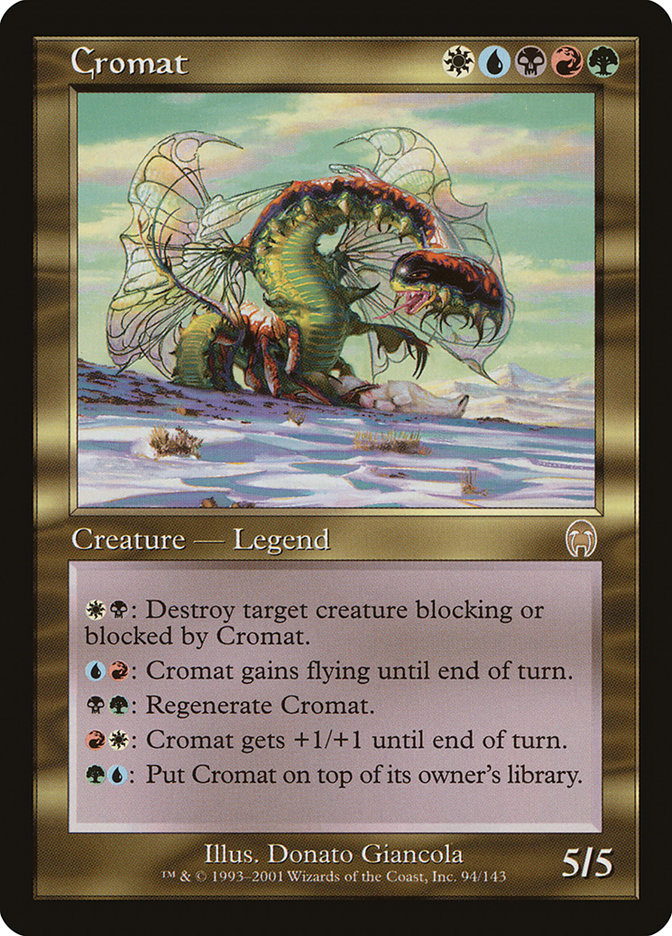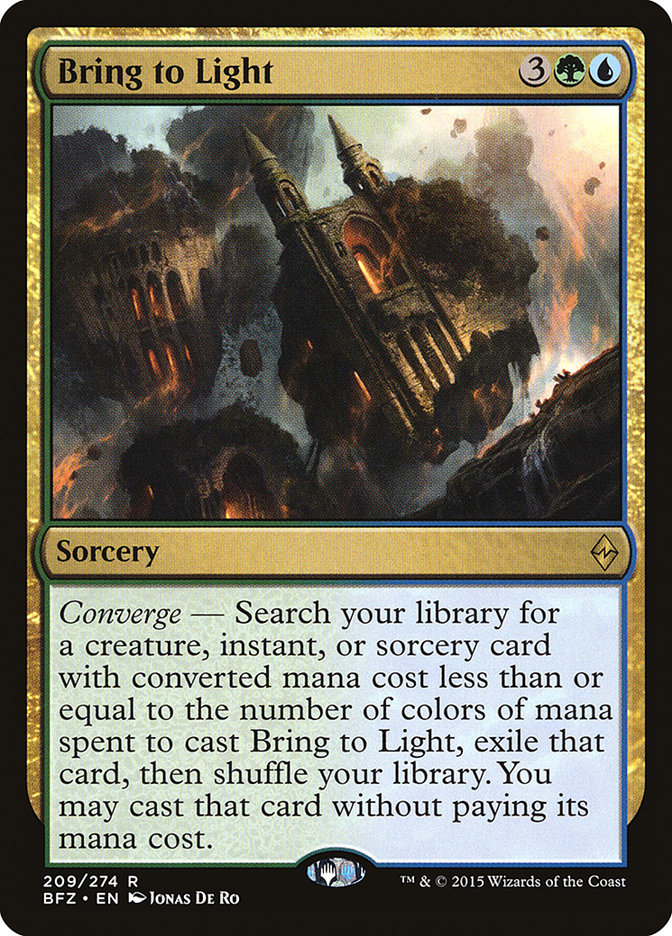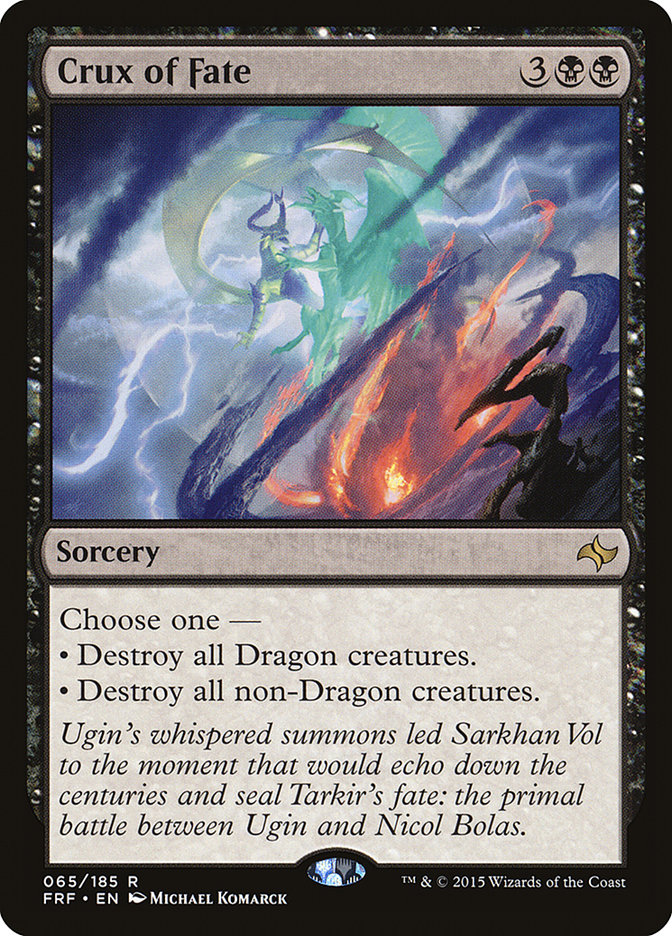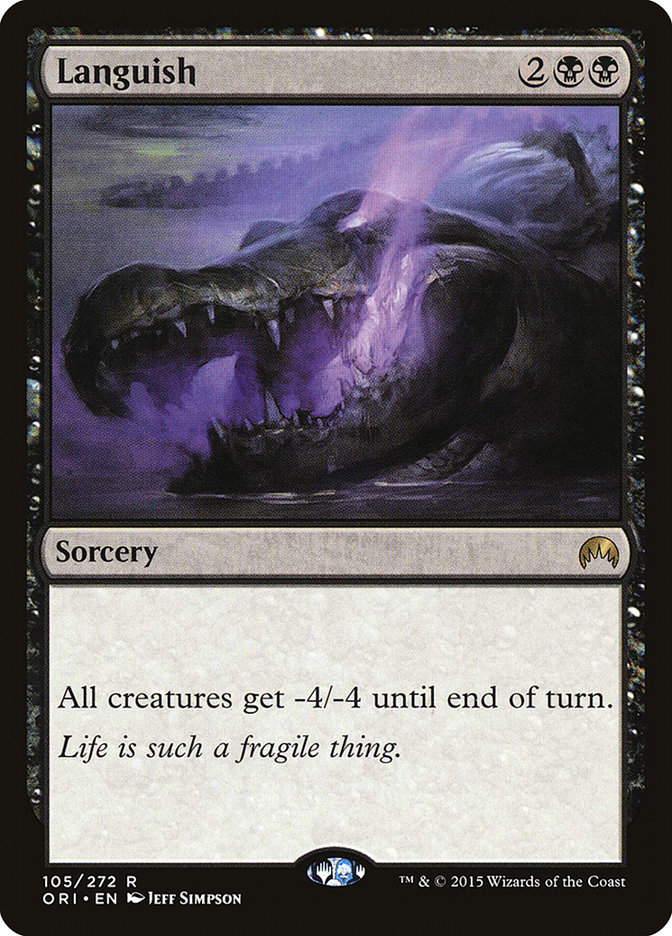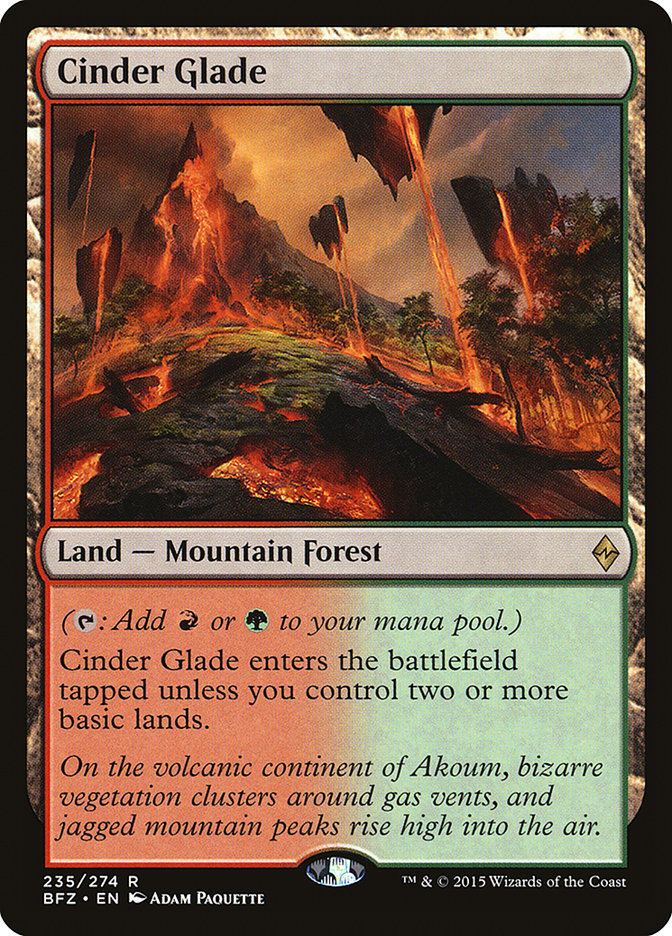I’ve been getting the tingle lately. And I don’t mean the bad kind of tingle, where a nun randomly pops out of the shadows to hit your hand with a ruler. I
mean the good kind. The brewer’s kind. This format is so flush with possibilities that I don’t even know where to begin. Well, that’s not exactly true. I
know where I want to begin, but I don’t know how to begin.
But after sitting next to my computer, chomping down on Deez brand nuts and humming the theme song of Friends, I had a bit of an epiphany. And by that I
mean I read a bunch of articles and saw a card being built around that I really liked.
After hours (minutes really) of research, I came to the conclusion that there is one card that people aren’t giving enough credit. The fact that the mana
works around this card is absolutely ridiculous, because it requires all five colors of mana. I’m sure you can guess what card I’m talking about.
But let’s not get too behind ourselves. No one wants to listen to all the chaff about how great I am, or how great my decks are. I won’t show you my
long-listed resume’ of both accomplishments and accolades. I won’t tell you about how I made Delver a deck. I won’t tell you about how I literally just won
an Open about a month ago (mostly because that was Modern, and we’re talking about Standard). No, let’s not start there.
Let’s start here.
Creatures (17)
- 4 Siege Rhino
- 2 Tasigur, the Golden Fang
- 4 Den Protector
- 1 Dragonlord Ojutai
- 4 Jace, Vryn's Prodigy
- 2 Nissa, Vastwood Seer
Lands (26)
Spells (17)

So you might be asking yourself a few questions. What’s the deal with this deck? Why does it play so many colors? What is a “Prairie Stream?”
Well, read on to find out the answers to those questions and hopefully one or two other ones. Because honestly, I don’t really know what questions you’re
going to ask. This is basically the world’s most awkward guessing game.
On a serious note, this deck feels great. And in the early days of a new Standard season, that’s the only positive thing I can say about a deck.
The manabase looks ridiculous and is likely off by five to ten lands, but I haven’t had too much trouble casting all my spells. Jace, Vryn’s Prodigy also
does a lot of work in smoothing out your early turns, but I don’t think we’ll be able to rely on him too much. He has quite a big target on his head.
But the rest of the deck runs smooth as a…well…something that’s really smooth. Like peanut butter, or BBD’s freshly shaven head. I tried out Evolving
Wilds for a time, but having any lands enter the battlefield tapped is a pretty big deal in the lategame. With so much top-end and not a lot of early stuff
going on, you can’t afford to draw Evolving Wilds as your fourth or fifth land drop and still expect to be in the game.
And before you go getting any crazy ideas that I’m the originator of this deck…don’t. There is no such thing as an original deck. Someone built it first,
on some forum, somewhere. You aren’t special, and neither am I. We’re just a couple of humans slamming ideas back and forth until someone is brave enough
to put it together and actually try it. And over the last few days, this is the deck I’ve been wracking my brain over.
Is it good? I think so. Will it be good once the dust settles and we actually have a metagame to look at? I honestly have no idea. With two Standard Opens
and a Pro Tour in the next three weeks, this deck will probably look nothing like it does today by that point. It might even cease to exist, if you believe
in that sort of thing. But what I do know is that this collection of lands and spells work together like peanut butter and jelly (Yeah, that’s another
peanut butter reference. So what?).
So what makes this deck flow? What is the reason to play this deck at the Open Series in Indianapolis this weekend?
The Poppa. The Docta. Mr. Siegeman Rhinoceros himself. This guy…he just doesn’t know when to quit. It seems like whenever you play against a Siege Rhino
deck, they always draw two, three, and sometimes (the dream) four of them. The first one is rarely a problem, but it can be really tough to come back from
the second and third one. The incremental life lost from fetchlands and the occasional drain for three is pretty tough on a mere twenty life points. Maybe
Siege Rhino wouldn’t be so good in Commander, but I’ll leave that analysis to Bennie Smith.
He knows more about these things.
If you aren’t casting Siege Rhino, then you’re probably making a mistake. After a week or two, casting something besides Siege Rhino is probably fine, but
for now this is it. This is what we know is good. This is what we want to focus on. So how can we play more than four copies of Siege Rhino?
Bring to Light is really Bringing the Pain in this deck, and it doesn’t really stop after the first one. Casting one Siege Rhino is great, but casting
Siege Rhino for three or four turns in a row is better. That’s just science. And with Jace, Vryn’s Prodigy flipping into some awkwardly named Jace, the
Planeswalker on the back, who can just so happen to do a great Snapcaster Mage impression, you can keep casting Bring to Light until you finally remember
the actual name of the card. Honestly, I forgot the name of the card right before writing this article, and I’ve cast it twenty or so times by now.
Den Protector also does some cool stuff in the deck. Against some matchups, searching out one of your package spells like Silumgar’s Command or Utter End,
you will want to draw more virtual copies of those cards (aside from the initial draw/Bring to Whatever). Den Protector makes sure you can keep the board
free and clear of annoyances like opposing Siege Rhinos. Or I guess…planeswalkers?
But alongside Den Protector, both Siege Rhino and Nasty Tasigurasty do a great job at actually pressuring the opponent. With so much virtual card
advantage, and actual card advantage, you just need to find a way to close. Nissa, Vastwood Seer (and flipside Sage Advice Columnist) can also accompany
your merry band of giant dorks on their journey. Both parts of her flipped side are phenomenal in this deck since you can play the long game or try to
close it out if they’re too far behind from Siege Rhino drains.
The trick with Bring to Light is making sure you can cast it on turn 5 with the full amount of sunburst…er…converge. Eh, let’s just call it sunverge
for now.
But if you can cast it on turn 5 for the full amount, finding a Dragonlord Ojutai, Crux of Fate, or Silumgar’s Command is awesome. You can, in fact, even
find another Bring to Light, so long as you have an Ornithopter or something in your deck. I suppose you could maybe cast Ancestral Visions from the second
Bring to Light, but that might be trying a bit too hard. Regardless, building a sweet toolbox for Bring to Light isn’t all that difficult, as long as those
spells can be great in multiple different spots and you don’t absolutely hate yourself when you draw one.
Crux of Fate and Languish are your go-to-sweepers for whatever sticky situation you might be in. Dragonlord Ojutai and Crux of Fate off back-to-back Bring
to Lights is….”Lights” out against most creature-based decks in the format. Get it? “Lights out?” Whatever, it was a good joke. You just don’t get my
sense of humor I guess. Nerd.
Did you know that I literally make jokes the entirety of the time I’m awake? I’m just upset that most of those jokes are said into a blank computer screen.
This thing has been finicky for weeks. I’ve tried going to the Geek Squad at Best Buy, but you weren’t working. Because you didn’t like my jokes, and
you’re a geek.
You see? I knew you wouldn’t get it.
But enough with the rambunctious tone and over-the-top jokes. Let’s get down to business.
Standard featuring Battle for Zendikar is a wild animal. Like the long-forgotten sprawls of terrain that litter the plane, there is so much depth
and possibility…and that’s just with the manabase. When you think of Standard, you generally think about how weak it is compared to older formats like
Modern or Legacy. There are the occasional Standard formats where something is far too powerful and something needs to get the banhammer, but those are few
and far between. Usually we’re stuck jamming Stormbreath Dragon and Thundermaw Hellkite and Thragtusk and…you get the picture.
In a lot of ways, this format will be no different. Siege Rhino is the king of the roost, even if Siege Rhino isn’t actually good. The fact that a lot of
people are going to be jamming Siege Rhino means that you likely need to be jamming it too, or else the life loss from each recurring Siege Rhino will
eventually kill you. The easiest way to offset the life loss from Siege Rhino is to play one of your own.
I’m not saying other decks won’t be good. I’m not saying other decks won’t be great, and potentially even define the format. I’m saying that most
Abzan-based decks will have the tools necessary to pick apart the format, assuming we actually know what the format looks like. At the moment, this format
is an unknown entity. Cards like Reave Soul could be great, but I don’t want to show up to a tournament full of Esper Dragons and Siege Rhino with my
two-mana sorcery that doesn’t actually kill anything.
The same can be said for a lot of the removal spells in Standard. How can we know just how good Radiant Flames is going to be? How do we know if Utter End
or even Ruinous Path are going to be good enough? The fact that Utter End costs four mana and Ruinous Path is a sorcery are major drawbacks when you
compare them to Hero’s Downfall. In this new world, something that looks great in theory, like Ruinous Path, could end up being unplayable.
The saving grace for a card like Ruinous Path is that it has other uses. Against a lot of decks, the Abzan deck will play to a longer game. When Ruinous
Path becomes Shriekmaw, not to mention an optional Shriekmaw, you start to see it a bit differently. I’m not saying Ruinous Path is good or bad,
I’m saying that we don’t know.
So what else don’t we know?
A lot of cards and even decks look great on paper. Atarka Red looks great, aside from losing Stoke the Flames and Lightning Strike. Even Scythe Tiger and
the other landfall aggro creatures look great in a vacuum. But in actuality, these decks will have major holes in them. Aside from the fact that you
auto-lose to a couple of different spells, like Languish, you could just build your deck incorrectly and lose a game/match because of it.
Almost every single Atarka Red list I’ve seen is featuring four copies of Cinder Glade. This includes Tom Ross’s version, which he played in a recent VS Video. But you know what? Cinder
Glade is going to be Shivan Oasis unless it is your third land. And do you know how many two-land hands you keep with Atarka Red? Really? You don’t know?
Well it’s a lot!
But I get it. You don’t want to play a lot of lands that enter the battlefield tapped, and we don’t exactly have Karplusan Forest to work with. So how do
we work around it? The short answer is that you can’t. While the new Battle lands look like pure dual lands, they actually hurt pretty badly in the opening
hand. It is rare that I’ve wanted to have a Battle land in my opener, instead opting for literally any fetchland so that I can make sure I hit my colors
perfectly, and in the time frame that I want. When you open a hand with a Battle land, that is rarely a possibility, assuming you’re playing a bunch of
one-drop threats.
And if you aren’t playing a bunch of one-drops, then by all means, play as many Battle lands as you want. But I’m under the impression that no color
combination wants more than one of each. I’d rather play off-color fetchlands that can get my Battle lands (and one of my basic lands) so that I can set up
my early turns of putting basic lands onto the battlefield and have my fetchland/Battle land enter the battlefield untapped on the third or later turn.
The Bring to Light deck that I posted above plays one of each Battle land because it plays all five colors. I wouldn’t want more than three Battle lands
outside of playing five colors, and I think that says a lot. In time, people will find that they just need to build their deck in such a way that basic
lands cast most of their spells. If they don’t, then most of their lands will enter the battlefield tapped or they’ll just sit with a bunch of uncastable
cards in their hand while their opponent curves out perfectly.
That’s just the nature of the beast. Build for consistency over power and you’ll have better results in the long run. In Standard, it is very difficult to
come back from a game where you stumble. If you have one or two spells stuck in hand because you fetched the wrong land or built your manabase incorrectly,
it will cost you greatly. The cards are built in such a way that games can end quickly if one person isn’t participating.
I don’t know if the Bring to Light deck is a good deck. In context, any deck can be great. Brad Nelson makes a (modest) living trying to metagame with a
different Standard deck each week. He tends to supplement his income by posing as a bard for weddings and bar mitzvahs. Don’t worry about him. He’s living
just fine. But not everyone can have the sultry, silky voice that Bard Nelson does, and not everyone can change decks from week to week. Don’t lock
yourself in too early to what cards and decks you think are good before the format has had a chance to flesh itself out. In due time, we’ll all have what
we’re looking for.
As for me, I’m looking forward to eating some more of Deez Salty Nuts. Those things are downright delicious.

